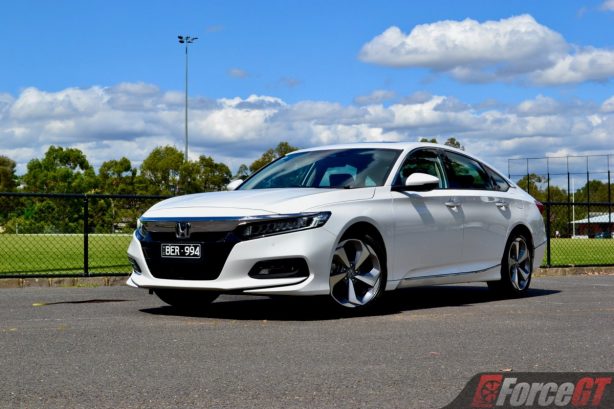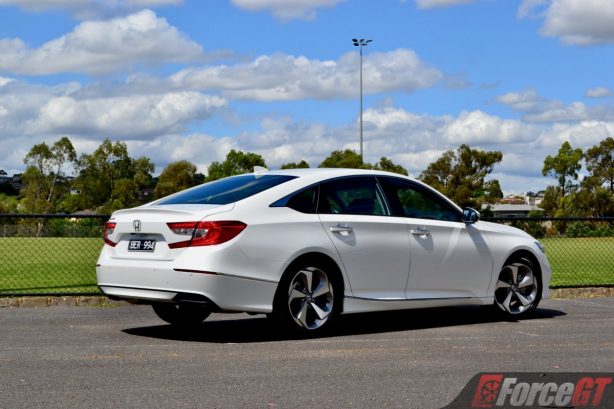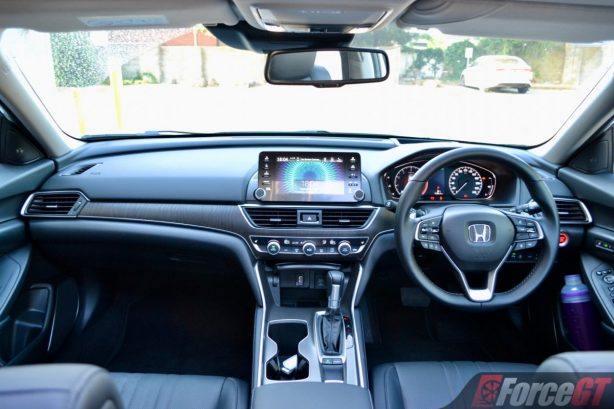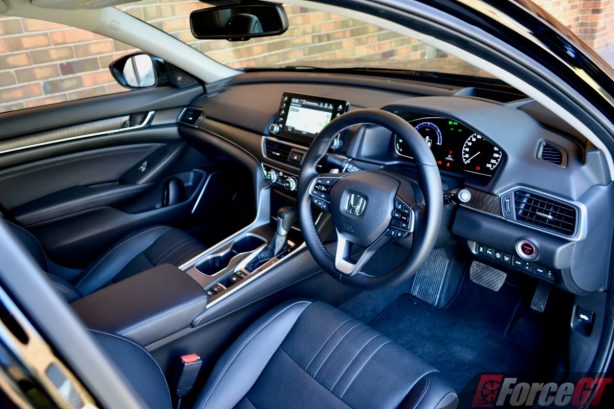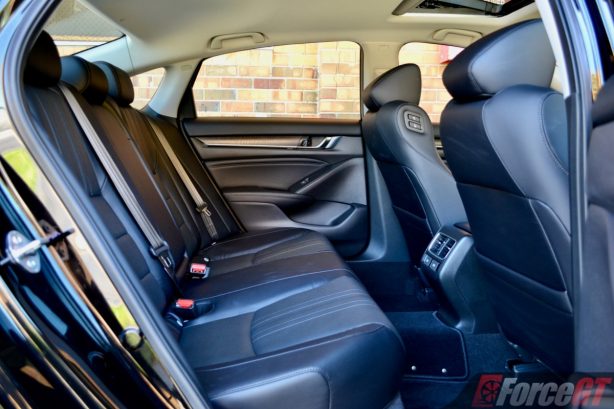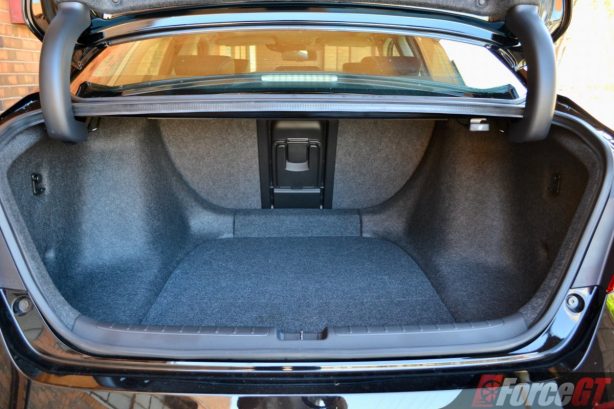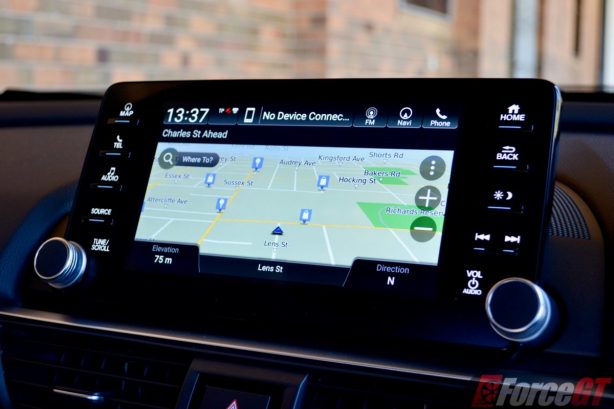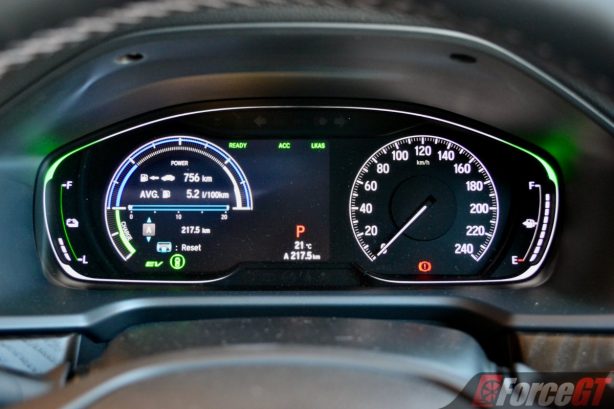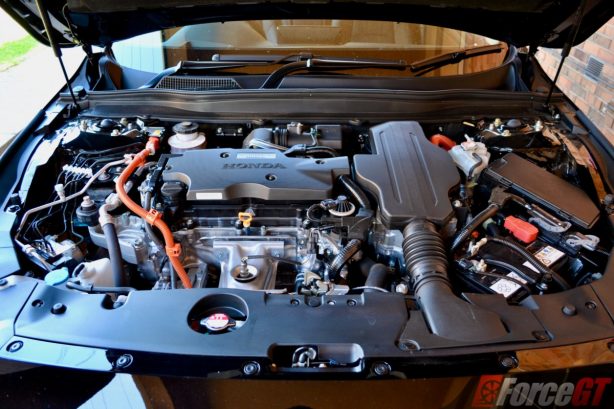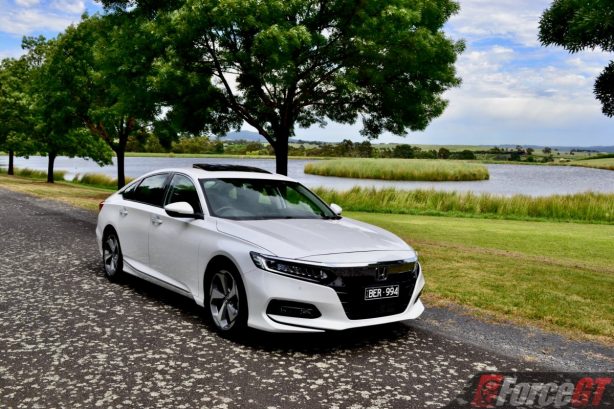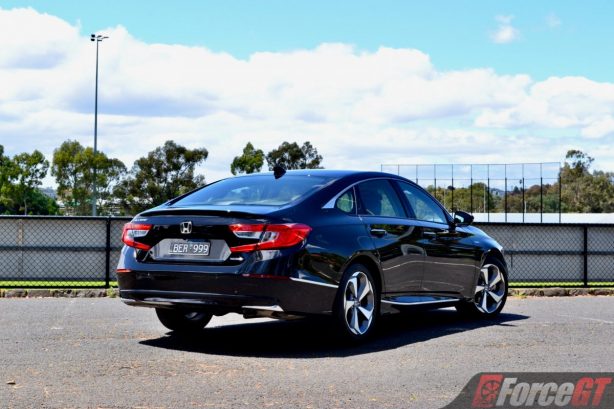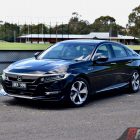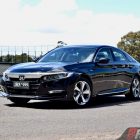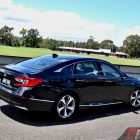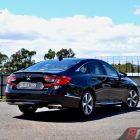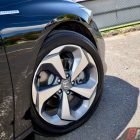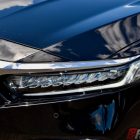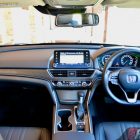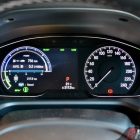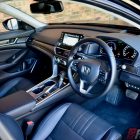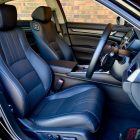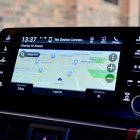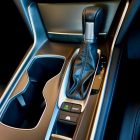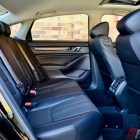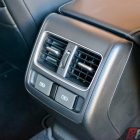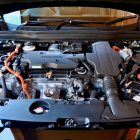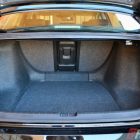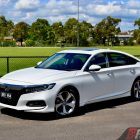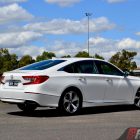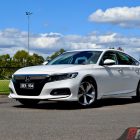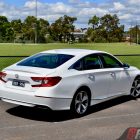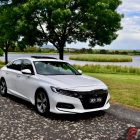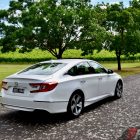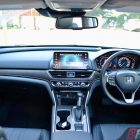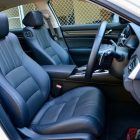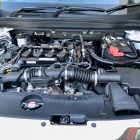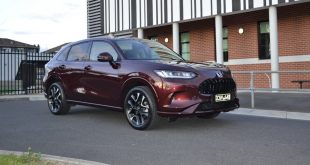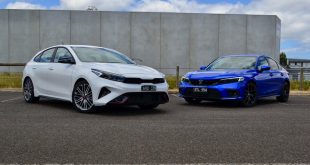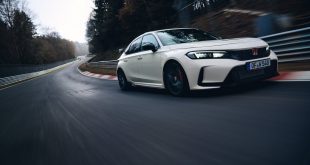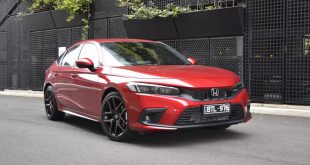The fifth generation Honda Accord from the mid-90s has always been my favourite Accord. To me, the 1995 CD5 Accord represents the high time in the nameplate’s rich 40-year history. With its clean, elegant yet sporty design, it looked superb during its time, and it still looks good today. I liked it so much that I bought one and happily owned it for a good five years.
That was my first and last Accord. Subsequent generations did not interest me that much, for they had gone all soft and dull. Until this new one came along.
Now in its tenth generation, the new Accord seems to have recaptured some of those magic that made the fifth-gen such widely admired. Firstly, the Accord is pretty again. Like the CD5, the new Accord looks purposeful and focused. The new ‘cyborg’ face neatly integrates the headlights with the grille, the latter which extends well into the bumper for a properly bold appearance. Granted, the grille is garnished with a chunky slab of chrome, but that only serves to reinforce its frontal visual statement.
The front fascia sets the tone for the rest of the design, with bold lines and creases sweeping backwards, culminating in the C shaped taillights and rear bumper. Similarly, the roofline curves rearwards, tapering gently into the short rear deck. The overall exterior styling is one that is sleek, modern and premium. A true return to form for Accord design.
Honda Australia is only bringing in the range-topping VTI-LX grade (in turbo petrol or hybrid guise priced respectively from $47,990 and $50,490 excluding on-road costs), and so all Accord variants sport smart-looking 18-inch alloy wheels, full LED lighting including fog lights, chrome accented door handles and a sunroof.
The CD5 Accord was known for its clean, uncluttered interior and I am pleased to see this design is shared in the cabin of the new Accord. The layered dashboard gives a sense of space, with all controls integrated within positioned where you expect them to be – ergonomics has always been a Honda hallmark.
There is no shortage of storage spaces and compartments, too, with thick door pockets, deep glove box and centre storage and two large cup holders in the front and two more behind the drop-down arm rest in the back.
Build quality is excellent throughout the cabin, with all fitment perfectly aligned with minimal gap. There is generous use of quality soft touch materials on the dashboard and door cards. Even the woodgrain-look trim inserts feel and look legit.
Being a medium family sedan, comfort is key and the Accord has got that covered. The front seats are sufficiently cushioned and have plenty of support. Finding the right seating position is easy through the multitude of powered adjustment. The back seats are equally plush with well positioned and soft headrests.
The Accord has always been one of the most spacious sedans in the segment and the latest generation continues this trait. The cabin is roomy and airy, with the vast glasshouse letting in plenty of natural light. Legroom throughout is vast, though the sedan’s sloping roof line does impede on rear headroom. Taller passengers in the back will have to duck while exiting the back seat to avoid brushing their heads against the door frame.
Further back, the boot offers a voluminous 570 litres of capacity – some 46 litres larger than that in the Toyota Camry. The space can be expanded by folding the rear seats, though they are not split folding meaning you cannot have any rear passenger when the rear seats are folded. That said, a handy removable hatch behind the middle rear seat allows long and slim items to protrude without having to fold the seats.
In terms of technology, the Accord uses an infotainment system that is vastly more superior than the rest of the Honda range and I find it odd that this is not deployed to other Honda models. The 8-inch touchscreen display is crisp, with a more modern user interface and sharper graphics. The menu structure is more intuitive, too, with physical shortcut buttons lining both sides of the screen to further improve usability.
Apple CarPlay and Android Auto are standard, so are DAB+ digital radio, Bluetooth connectivity and built-in satellite navigation.
The instrumentation cluster combines a digital screen with a conventional analogue speedometer gauge. A variety of driving information can be displayed on the digital screen, including the tachometer, energy transfer illustration (hybrid model) and trip computer. Such high clarity is the digital cluster that the integration with the other analogue half looks impressively seamless.
One minor annoyance of the digital cluster is the inability to simultaneously display the tachometer and fuel economy gauge for the petrol model, even though there is real estate on the cluster to do so.
Complementing the unique instrumentation is a head-up display that remains visible through polarised lenses.
Other features included as standard in the Accord are a wireless charging pad, 4 USB ports, front passenger seat adjust switch (accessible by rear passengers), tyre pressure monitoring system, a 452W premium sound system with 10 speakers including a subwoofer, keyless entry with push button start and remote engine start using the key fob.
Safety is taken care of by the Honda Sensing suite of driver-assist technologies which include Forward Collision Warning (FCW), Automatic Emergency Braking (AEB), Lane Departure Warning (LDW), Lane Keep Assist System (LKAS), Road Departure Mitigation System (RDM), Adaptive Cruise Control (ACC) with Low Speed Follow (LSF), Rear Cross Traffic Alert (RCTA) and Automatic High Beam (AHB).
Making parking a breeze are the 360-degree view camera, parking sensors and Smart Parking Assist (SPA) automatic parking system.
LaneWatch, Honda’s version of blind spot monitoring system, provides a camera view of the passenger-side roadway on the center touchscreen when the left indicator is engaged or the LaneWatch button is pressed. I find it a gimmick more than anything as it requires you to take your eyes off the side mirror to view the camera feed on the centre screen. And it is only installed on the passenger side. I would much rather have the conventional Blind Spot Monitoring system found in rivals.
The Accord is offered with two powertrains – a 1.5-litre four-cylinder turbocharged petrol engine and a 2.0-litre four-cylinder petrol-electric hybrid. The turbo petrol unit develops 140kW of power @ 5500rpm and 260Nm of torque @ 1600-5000rpm, with average fuel consumption rated at 6.5L/100km. The hybrid produces a combined output of 158kW @ 5000-6000rpm, accompanied with 315Nm of instant torque that lasts up to 2000rpm. On paper, the hybrid’s fuel economy averages just 4.3L/100km. Both engines are paired with CVT automatic.
While the 1.5-litre turbo is mostly adequate for the daily grind, it can struggle going up a hill on a full load. It can also get vocal when revved. The CVT auto is mostly smooth and quiet though, keeping engine revs low as much as possible to maximise fuel economy yet responding quickly to a heavy throttle.
Of the two powertrains, the hybrid is the one that I enjoyed driving more (surprisingly). More power and torque aside, the hybrid offers superb refinement and quietness. The transition between engine and electric power is virtually imperceptible, in fact it is one of the smoothest hybrids I have ever sampled. Unless you are hammering the throttle, the Accord hybrid feels almost like a full electric car.
Typically, the brake feel in a hybrid vehicle is wooden due to regenerative braking, but in the Accord it remains nicely progressive and easy to regulate for smooth stops.
Regardless of the powertrain, the Accord corners well, maintaining good composure and control even in the tightest of bends. The steering, though precise and easy, does not offer much feel for the road.
A testament to its well-balanced suspension tuning, ride quality is impressive, with the Accord soaking up bumps and ruts with aplomb. The long wheelbase also aids in highspeed stability, making the Accord a relaxing and comfortable long distance cruiser.
Over my weeklong test in both the petrol and hybrid variants of the Accord, I can report a real world average fuel economy of 7.2L/100km for the petrol and 5.4L/100km for the hybrid. While the petrol’s fuel economy is respectable, the hybrid is truly thrifty for a mid-size sedan despite being a litre off the rated figure.
Verdict
Design & Comfort
Performance & Handling
Quality
Economy
Equipment & Features
OUR SCORE
4.0/5
+ Plus
- Sharp design
- Efficient powertrains
- Comfortable ride and tidy handling
- Spacious cabin
– Minus
- Tight rear headroom
- Conventional blind-spot monitoring system is better
- No split folding rear seats
Overall
The tenth generation Honda Accord is no doubt the best iteration of the nameplate since the much-loved fifth generation. It does most things right of a mid-size family sedan. It has got the good looks, and the cabin is spacious, the materials are good and the tech is up to date. The hybrid is the pick over the turbo petrol for its refinement, linear power delivery and fuel efficiency.
2021 Honda Accord Pricing and Specification
| Price (Excl. on-road costs): | VTi-LX 1.5L Turbo: $ 47,990 VTi-LX 2.0L Hybrid: $ 50,490 |
| Warranty: | 5 years/Unlimited kilometres |
| Country of Origin: | Japan. Built in Thailand |
| Service Intervals: | 12 months / 10,000km |
| Engine: | 1.5-litre turbocharged inline four-cylinder petrol: 140kW @ 5500rpm, 260Nm @ 1600-5000rpm 2.0-litre inline four-cylinder petrol hybrid with electric motor: 158kW @ 5000-6000rpm, 315Nm @ 0-2000rpm |
| Transmission: | CVT automatic |
| Drivetrain: | Front-wheel drive |
| Power to Weight Ratio (W/kg): | 94.7 (turbo); 100.6 (hybrid) |
| Combined Fuel Consumption (L/100km): | Claimed: 6.5 / Tested: 7.2 (turbo) Claimed: 4.3 / Tested: 5.4 (hybrid) |
| RON Rating: | 91 |
| Fuel Capacity (L): | 56 (turbo); 48 (hybrid) |
| Body: | 4-door sedan, 5 seats |
| Safety: |
|
| Dimensions (L/W/H/W-B) mm: | 4,904/1,862/1,450/2,830 |
| Boot Space (min/max) (L): | 570 |
| Kerb Weight (kg): | Turbo: 1,504 Hybrid: 1,591 |
| Entertainment: | 8-inch colour touchscreen with Bluetooth, Apple CarPlay, Android Auto, USB, Aux in, DAB+, 10 Speakers with subwoofer |
Competitors: Toyota Camry, Mazda6, Volkswagen Passat, Hyundai Sonata, Ford Mondeo, Peugeot 508, Subaru Liberty
 ForceGT.com Car News, Car Reviews, Video Reviews, Tuning and much more.
ForceGT.com Car News, Car Reviews, Video Reviews, Tuning and much more. 